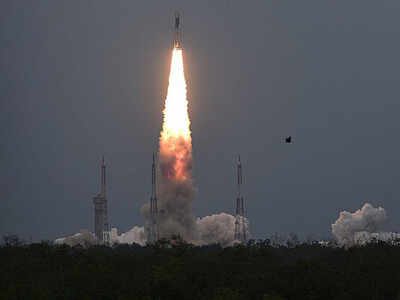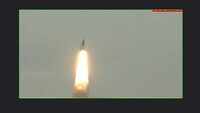
Highlights
SRIHARIKOTA: The Indian Space Research Organisation (Isro) successfully launched its second lunar mission — Chandrayaan-2 — getting one step closer to joining an elite club of nations that have landed probes on Moon.
While it will take another 48 days for Vikram, the lander, to soft-land on Moon, Monday's launch has Isro in good spirits, given the fact that the agency had to cancel its first scheduled launch on July 15 after discovering a leak in the cryogenic stage of GSLV-MkIII. The launch vehicle performance was flawless.
Chandrayaan-2 is more complex than Chandrayaan-1, costing more than double the first mission cost— Rs 978 crore compared to less than Rs 400 crore — as it will soft land Vikram (the lander) and Pragyan (the rover) in a high plain between two craters, Manzinus C and Simpelius N, at a latitude of about 70° south, on September 7.
Among other things that Isro hopes to do on Moon is reconfirm the presence of water, understand the composition of the lunar soil, study its rocks and so on. Chandrayaan-2 has carried 14 scientific instruments to Moon, including a passive payload from Nasa.
Chandrayaan-2, Isro chairman K Sivan said, will open up several new possibilities for India. And, as the world looks at Moon with renewed interest — the US, Europe and China, all going big with their plans for Moon — India's mission is being keenly watched.
As India waits for the destination, the Moon landing, here are some things simplified:
1) Going where no-one has ...
a) Isro claims that Chandrayaan-2 will go where no country has ever gone before: The Moon's south polar region. But the Chinese Chang'e 4 landed around the same region earlier this year.
b) The aim is to improve understanding of the Moon and make discoveries that will benefit humanity.
c) Isro says these insights and experiences aim at a paradigm shift in how lunar expeditions are approached for years to come, propelling further voyages into the farthest frontiers.
2) The Moon ...
a) The Moon is the closest cosmic body at which space discovery can be attempted and documented.
b) It's also a promising test-bed to demonstrate technologies required for deep-space missions.
c) Chandrayaan-2 attempts to foster a new age of discovery, increase our understanding of space and stimulate the advancement of technology.
3) Why the Moon?
a) Moon provides the best linkage to Earth's early history as it offers an undisturbed historical record of the inner Solar system environment.
b) Origin of the Moon still needs further explanations. And, extensive mapping of the surface to study variations in its composition is essential to trace back the origin and evolution.
c) Evidence for water molecules discovered by Chandrayaan-1 requires further studies on the extent of water molecule distribution on the surface, below the surface and in the tenuous lunar exosphere to address the origin of water on Moon.
4) Why explore the Lunar South Pole?
a) The South Pole is especially interesting because of the lunar surface area here that remains in shadow is much larger than that at the North Pole.
b) There's a possibility of presence of water in permanently shadowed areas around it.
c) Also, South Pole region has craters that are cold traps and contain a fossil record of the early Solar System.
While it will take another 48 days for Vikram, the lander, to soft-land on Moon, Monday's launch has Isro in good spirits, given the fact that the agency had to cancel its first scheduled launch on July 15 after discovering a leak in the cryogenic stage of GSLV-MkIII. The launch vehicle performance was flawless.
Chandrayaan-2 is more complex than Chandrayaan-1, costing more than double the first mission cost— Rs 978 crore compared to less than Rs 400 crore — as it will soft land Vikram (the lander) and Pragyan (the rover) in a high plain between two craters, Manzinus C and Simpelius N, at a latitude of about 70° south, on September 7.
Among other things that Isro hopes to do on Moon is reconfirm the presence of water, understand the composition of the lunar soil, study its rocks and so on. Chandrayaan-2 has carried 14 scientific instruments to Moon, including a passive payload from Nasa.
Chandrayaan-2, Isro chairman K Sivan said, will open up several new possibilities for India. And, as the world looks at Moon with renewed interest — the US, Europe and China, all going big with their plans for Moon — India's mission is being keenly watched.
As India waits for the destination, the Moon landing, here are some things simplified:
1) Going where no-one has ...
a) Isro claims that Chandrayaan-2 will go where no country has ever gone before: The Moon's south polar region. But the Chinese Chang'e 4 landed around the same region earlier this year.
b) The aim is to improve understanding of the Moon and make discoveries that will benefit humanity.
c) Isro says these insights and experiences aim at a paradigm shift in how lunar expeditions are approached for years to come, propelling further voyages into the farthest frontiers.
2) The Moon ...
a) The Moon is the closest cosmic body at which space discovery can be attempted and documented.
b) It's also a promising test-bed to demonstrate technologies required for deep-space missions.
c) Chandrayaan-2 attempts to foster a new age of discovery, increase our understanding of space and stimulate the advancement of technology.
3) Why the Moon?
a) Moon provides the best linkage to Earth's early history as it offers an undisturbed historical record of the inner Solar system environment.
b) Origin of the Moon still needs further explanations. And, extensive mapping of the surface to study variations in its composition is essential to trace back the origin and evolution.
c) Evidence for water molecules discovered by Chandrayaan-1 requires further studies on the extent of water molecule distribution on the surface, below the surface and in the tenuous lunar exosphere to address the origin of water on Moon.
4) Why explore the Lunar South Pole?
a) The South Pole is especially interesting because of the lunar surface area here that remains in shadow is much larger than that at the North Pole.
b) There's a possibility of presence of water in permanently shadowed areas around it.
c) Also, South Pole region has craters that are cold traps and contain a fossil record of the early Solar System.
Download The Times of India News App for Latest India News.
more from times of india news
World Cup 2019
Trending Topics
LATEST VIDEOS
More from TOI
Navbharat Times
Featured Today in Travel
Quick Links
Rajasthan election 2019Andhra Lok Sabha electionGujarat Election 2019Karnataka Election 2019MP Lok Sabha electionMaharashtra election 2019West Bengal Lok SabhaTamil Nadu election 2019UP Election 2019Bihar election 2019UP Election DateAndhra Election DateBihar Election DateAndhra Assembly ElectionLok SabhaMP Election DateMaharashtra Election DateShiv SenaYSRCPTDPWB Election DateJDUCongressBJP newsGujarat Election DateSC ST ActUIDAIIndian ArmyISRO newsSupreme CourtRajasthan Election DateTelangana Election DateTamilrockers 2018Uttarakhand newsSikkim newsOrrisa newsKarnataka Election DateNagaland newsSatta KingManipur newsMeghalaya news
Get the app









